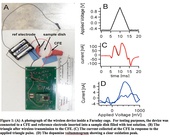Highlight
Microdevices to Advance High-Throughput Drug Testing
Achievement/Results
Dopamine is a neurotransmitter that plays an important role in the control of movement and reduced dopamine levels are the underlying cause of Parkinson’s disease. Dopamine is also of great importance in social behavior and drug addiction. For the study of dopamine function in these mechanisms, it is important to develop robust inexpensive systems that allow measurement of dopamine release in unrestrained research animals such that their motor function and behavior is not inhibited by the experimental situation.
Release of dopamine can be measured in vivo with implanted carbon fiber electrodes (CFEs) using fast scan cyclic voltammetry (FSCV) (Baur et al. 1988). In FSCV, a triangle voltage pulse is applied between the CFE and a reference electrode increasing from -450 mV to +1000 mV and back to -450 mV over a10 ms time interval with a repetition rate of 10 pulses per second while the resulting currents at the CFE are recorded. Dopamine release produces a small Faradaic current superimposed on a large mostly capacitive background current. To improve the resolution of the Faradaic current, a voltammetry amplifier with capacitance compensation was designed and integrated with a commercially available Bluetooth chip including D/A and A/D converters. Graduate student Alycia Gailey developed a battery-operated wireless recording device (Fig. 1A) that successfully detected dopamine down to 2 µM concentration (Fig.1B-D), which is in the physiological range.
Address Goals
Based on this research a major outreach activity of Alycia Gailey was the development of a learning unit at the local Ithaca High School, teaching students how scientists use electronics in their research. Examples include filtering and amplification of neurophysiological signals and electrocardiography signals. High school students will record their voice into a computer using a microphone and analyze the frequency spectrum of the recording. They will record their voice while playing noise at the same time and use digital low pass filters with different filter cutoff frequencies to retore their voice amidst the noise. This lab will teach students how to interpret frequency spectra of a signal and how to design a filter that filters out unwanted artifacts while still preserving the part of the signal that is meaningful. In the advanced placement physics class, students will build RC circuits and operational amplifier circuits, which they will use to filter various signals before recording.
The project was funded by an IGERT (Integrative Graduate Education and Research Traineeship) for Flexible Electronics for Biological and Life Science Applications fellowship and a CLIMB (Cornell’s Learning Initiative in Medicine and Biomedical engineering) K-12 outreach fellowship.






